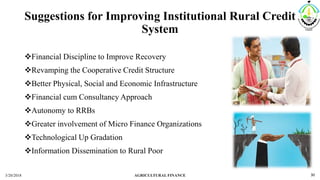Agricultural Finance Supporting Farmers Economic Growth

Agricultural finance plays a crucial role in supporting the agricultural industry and enhancing rural development. It provides farmers and other stakeholders with the necessary funds to invest in farming activities, improve productivity, and maintain sustainable agricultural practices. In this post, we will explore various aspects of agricultural finance, including its importance, challenges, and potential solutions.
What is Agricultural Finance?
Agricultural finance refers to the financial services and products that cater specifically to the needs of farmers, agribusinesses, and rural communities. It encompasses a wide range of financial activities, such as providing loans, insurance, savings accounts, payment solutions, and risk management tools.
The main objective of agricultural finance is to ensure a consistent flow of funds to farmers and rural businesses, allowing them to overcome financial constraints and effectively manage their agricultural operations. It helps bridge the gap between the seasonal nature of agricultural production and the need for continuous investment.
Ideas For Agricultural Finance
There are several ideas and strategies that can contribute to the improvement of agricultural finance:
- Enhanced access to credit: Financial institutions should develop innovative credit products and relaxation in collateral requirements to make credit more accessible to farmers, especially small-scale farmers who often face difficulty in satisfying traditional lending criteria.
- Digitization of financial services: The adoption of digital technologies can significantly enhance the efficiency and transparency of agricultural finance. Mobile banking, for example, allows farmers to access financial services conveniently and at lower costs.
- Collaboration between financial institutions and agricultural organizations: Partnerships between banks and agricultural organizations can lead to the development of tailored financial products and services that better suit the needs of farmers and agribusinesses.
- Investment in agricultural infrastructure: Developing infrastructure, such as irrigation systems, storage facilities, and transport networks, can improve agricultural productivity and attract more investment in the sector.
- Promotion of agricultural insurance: Insurance products specifically designed for agriculture can help farmers mitigate risks associated with natural disasters, pests, diseases, and market fluctuations.
Recommendations for Agricultural Finance
Based on the above ideas, the following recommendations can be made to enhance agricultural finance:
- Government support: Governments should create an enabling policy and regulatory environment that encourages financial institutions to serve the agricultural sector. They should also provide financial incentives and subsidies to promote the adoption of modern agricultural practices.
- Investment in financial literacy: Farmers and rural entrepreneurs should be equipped with the necessary knowledge and skills to make informed financial decisions, manage their finances effectively, and understand the available financial products.
- Research and development: Continuous research and development in agricultural finance are essential to identify emerging trends, innovative solutions, and best practices. This can help shape policies and strategies to address the evolving needs of farmers and agribusinesses.
Listicle of Agricultural Finance
Here is a listicle highlighting key aspects of agricultural finance:
- Importance of Agricultural Finance: Explore the significance of agricultural finance in supporting food security, rural development, and poverty reduction.
- Challenges in Agricultural Finance: Discuss the major obstacles faced by financial institutions, farmers, and agribusinesses in accessing suitable financial services.
- Sustainable Financing for Agriculture: Highlight sustainable financing models and practices that can contribute to the long-term viability of the agricultural sector.
- Innovative Agricultural Finance Solutions: Explore innovative approaches, such as crowdfunding, impact investing, and climate finance, in agricultural finance.
- Role of Agricultural Finance in Climate Change Adaptation: Examine how agricultural finance can support farmers in adapting to the impacts of climate change and building resilience.
Question & Answer: Agricultural Finance
Let's address some common questions related to agricultural finance:
1. How does agricultural finance differ from traditional finance?
Agricultural finance differs from traditional finance in terms of the unique risks associated with agricultural activities, the seasonal and cyclical nature of farming, and the specific financial needs of farmers and rural communities. Traditional financing methods may not consider these factors and may not be tailored to suit the requirements of the agricultural sector.
2. Are there any specialized financial institutions that focus solely on agricultural finance?
Yes, there are specialized financial institutions such as agricultural development banks, microfinance institutions, and rural credit cooperatives that primarily serve the agricultural and rural sectors. These institutions have a better understanding of the specific challenges faced by farmers and have designed financial products accordingly.
3. How can agricultural finance contribute to achieving sustainable agriculture?
Agricultural finance can contribute to achieving sustainable agriculture by providing funds for investments in sustainable farming practices, resource-efficient technologies, and environmentally friendly production systems. It can also support the adoption of organic farming, agroecology, and integrated pest management techniques that promote biodiversity, soil health, and natural resource conservation.
Summary of Agricultural Finance
Agricultural finance plays a vital role in ensuring the financial stability and growth of the agricultural sector. It provides farmers and agribusinesses with the necessary funds to invest, innovate, and sustain their operations. Accessible and affordable agricultural finance can contribute to improved food security, poverty reduction, and rural development. However, challenges such as limited access to credit, inadequate financial literacy, and the risks associated with agricultural production need to be addressed for agricultural finance to reach its full potential.
In conclusion, agricultural finance is a critical component of a comprehensive strategy to support agriculture and rural development. By developing innovative financial products, enhancing access to credit, and promoting sustainable financing models, we can empower farmers and rural communities to thrive and contribute to a more food-secure and sustainable future.


Post a Comment for "Agricultural Finance Supporting Farmers Economic Growth"